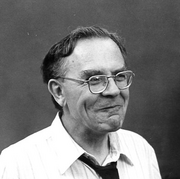Geoffrey Wilkinson
| Sir Geoffrey Wilkinson | |
|---|---|
 |
|
| Born |
14 July 1921 Todmorden, West Riding of Yorkshire, England |
| Died | 26 September 1996 (aged 75) London, England |
| Nationality | British |
| Fields | Inorganic chemistry |
| Institutions | |
| Alma mater | Imperial College London |
| Doctoral advisor | Henry Vincent Aird Briscoe |
| Known for | Homogeneous transition metal catalysis |
| Notable awards |
|
Sir Geoffrey Wilkinson FRS (14 July 1921 – 26 September 1996) was a Nobel laureate English chemist who pioneered inorganic chemistry and homogeneous transition metal catalysis.
Wilkinson was born at Springside, Todmorden, in the West Riding of Yorkshire. His father, Henry Wilkinson, was a master house painter and decorator; his mother, Ruth, worked in a local cotton mill. One of his uncles, an organist and choirmaster, had married into a family that owned a small chemical company making Epsom and Glauber's salts for the pharmaceutical industry; this is where he first developed an interest in chemistry.
He was educated at the local council primary school and, after winning a County Scholarship in 1932, went to Todmorden Grammar School. His physics teacher there, Luke Sutcliffe, had also taught Sir John Cockcroft, who received a Nobel Prize for "splitting the atom".
In 1939 he obtained a Royal Scholarship for study at Imperial College London, from where he graduated in 1941.
In 1942 Professor Friedrich Paneth was recruiting young chemists for the nuclear energy project. Wilkinson joined and was sent out to Canada, where he stayed in Montreal and later Chalk River Laboratories until he could leave in 1946. For the next four years he worked with Professor Glenn T. Seaborg at University of California, Berkeley, mostly on nuclear taxonomy. He then became a Research Associate at the Massachusetts Institute of Technology and began to return to his first interest as a student - transition metal complexes of ligands such as carbon monoxide and olefins.
...
Wikipedia
